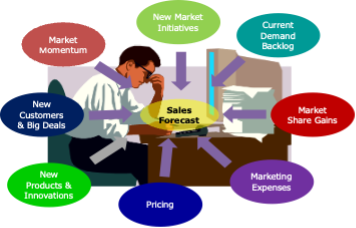The Tragedy of the CFO Staying in Their Own Lane

Years ago, a global consulting company, developed the slogan,
“Each employee comes with their own brain at no extra cost.”
In the years since coming across that slogan, I have had the opportunity to deliver talks to the Oregon Society of CPA’s, Institute of Management Accountants, the Financial Executives Network Group, and other professional organizations with Finance and Accounting professionals in the crowd. In each case, I have challenged listeners to become more assertive in sharing their influence, experience, and knowledge in the organizations they work for, by constructively speaking out during their firm’s decision-making process.
During one talk, I asked a group of high-level Finance executives to answer, with a show of hands, if they used forecasts generated by the Marketing & Sales team (for the top line) and the Operations team (for the expense lines).
About everyone showed their hands.
I followed that question with another, asking if they believed those forecasts?
I observed significantly fewer hands.
Finally, I asked if they challenged those forecasts, then contributed their influence, knowledge, and experience to arrive at more supportable and realistic numbers.
No hands!
Responsibility!
There is much at stake based on the process of formulating and achieving a financial forecast. Overstated or understated, the Finance Executive should feel a compelling responsibility to ensure forecasts are based on sound reasoning.
An overstated forecast creates the risk of underutilized assets, overcommitted expense levels, over-stocked inventories, slow market adoption of new products that delays the payback of the product’s development costs, misapplied cash, or labor inefficiencies. An understated forecast creates the risk of lost business due to inventory shortages, lack of operational capacity, extended lead times, and lengthened order-to-cash cycles.
Because of the implications and consequences of sales forecast inaccuracy, the CFO bears a responsibility to all the stakeholders of the company (employees, owners, customers, suppliers, banks, and the community) to contribute to its accuracy. Financial Executives must bring to bear their education, experience, and systems knowledge to help achieve forecast reality. To do so, they must have the courage to speak up.
Why do I mention courage? After the show of no hands, I challenged the group to explain why, with all the negative implications of bad forecasting and poor decision-making, they did not speak out. The answers ranged from “not my job”, “don’t want to rock the boat”, to “lack of market knowledge”, to “the boss sets the forecast”, to “I don’t talk to our customers”.
All those reasons are simply hiding places. They are excuses for not embracing the important responsibility for doing the right thing.
Based on the presumption that some advanced education in Finance, Economics, and Statistics exists in someone as senior as the CFO, here are two common areas (one in Operations and the other in Sales) to which the Finance Exec’s intellectual muscle can contribute to improved decision-making.
Capital Equipment Forecasts

A capital equipment expenditure usually means a large cash outlay. The purpose of those cash outlays might fall into any one of the following five categories (in order of importance):
- Regulatory/Safety (these expenditures are inappropriate, illegal, or dangerous to delay, if the need is truly compelling),
- Capacity Expansion (to meet current orders or rapidly expanding current market demand),
- Productivity Improvement (to increase bottom line cash generated from current backlog and demand),
- Capabilities Extension, (to increase the technical capability to take on new business that the company would otherwise not be able to service with current skills, equipment, and processes)
- Everything Else, (an upgraded employee break room, new signage on the building, repainting the company delivery trucks, etc.).
The role the CFO must play as the “conscience” of both the capital expenditure forecast and decision-making, is to: 1) assure that funding is allocated and committed in the proper order of importance and priority, and 2) discern the difference between Capacity and Capability.
To clarify…
Capacity driven expenditures add hard assets, equipment, and other critical resources to fulfill existing demand and backlog.
Capability driven expenditures add hard assets, equipment, and other critical resources that enable sales, fulfillment, and service of new opportunities requiring never-before adopted company processes and techniques. For example, the capability in question might entail adding 3D metal printing additive manufacturing equipment into a plastics injection molding business – an extension of corporate capabilities to service new markets, new customers, or more deeply penetrate current clients with new application needs.
Exercising the CFO brain muscle to understand the differences and implications of each type of expenditure is important.
A capacity expenditure is a relatively fast path to cash. It assumes the order backlog exists or is imminent.
In contrast, a capability expenditure may only represent a “build-it-and-they-will-come” scenario – a “BIATWC”.
If it is a BIATWC, then the CFO might consider challenging both the ops and sales teams for their rationale, by requesting to see the opportunities that are compelling the investment in the sales pipeline and assessing their probability of closing - before signing the check.
More than one of my clients have had serious challenges when buying expensive pieces of equipment based on the gamble of an unsupported BIATWC strategy while awaiting the arrival of the “they” – one to the degree of Chapter 11 bankruptcy.
CFO’s can easily recognize a capability-based strategy by the following phrase often use to justify them,
“If we only had ________, then we could sell ________.”
If the CFO hears this, it should trigger alarm bells.
TIP: Use CFO.University’s Capital Investment Analysis Request Form to add financial rigor to your capital allocation and spending process.
Sales Forecasts
Sales forecasts are another critical area that should benefit from the intellectual muscle power of the CFO. A thorough sales forecast requires more than a handful of inputs and considerations. See Figure 1.

Figure 1
Let me briefly touch on just three of these factors: 1) New Customers & Big Deals, 2) New Market Initiatives, and 3) New Products & Innovations:
1. New Customers and Big Deals
A salesperson must predict the probability of success of landing each of the “big deals” within their sales pipeline, by evaluating them according to six qualification criteria. Otherwise, the business cannot depend on the opportunity to produce revenue and profit within the forecast time window.
The qualifying criteria are:
Compelling Need: To what degree does the targeted customer have a compelling need to buy a solution to whatever problem is that your product helps them resolve?
Match: To what degree does your offering precisely meet that need?
Economic Value Proposition: To what degree is the value of such a solution compelling in the eyes of the customer?
Competitive Advantage: To what degree is your company’s solution overwhelmingly advantaged in delivering that value to the customer?
Champion: To what degree does your company have a champion within the customer’s organization that, for whatever reason wants and will fight his peers and bosses to select your solution?
Leverage: To what degree does this opportunity open other similar opportunities – either within the customer’s business or industry?
It is the CFO’s role to challenge the reality of Big Deals before permitting them to enter the budget or forecast. And one thing to remember, the only qualification perspectives that count are those of the customer. So, when the salesperson responds to these qualification questions, the CFO should ask whether the salesperson is answering from what he knows about the customer’s perspective or his own.
2. New Marketing Initiatives
There is an old saw that says,
“I know half my advertising budget is wasted. The problem is, I do not know which half.”
Most popular in the marketing budgets of today are marketing initiatives in rebranding and social media along with an occasional website redo. Most expensive parts of the budget are tradeshows and advertising.
Two points are important with respect to branding.
First, your company’s brand is important. It creates preference, premium prices, channel interest, and brand extension. But remember …
Your brand is the result of the market’s perception of the Quality of your products relative to competitors’ offerings, not the source of the market’s perception. A brand is not the company’s logo, tag line, corporate colors, or signs on the outfield wall of a pro baseball stadium.
3. New Products & Innovations
Professor Everett Rogers (1931-2004), University of New Mexico, published an incredibly thorough book (Diffusion of Innovations) about the market adoption of innovations. His work significantly influenced our understanding of how innovations spread within economic and social systems, emphasizing the importance of peer-to-peer communication in the modernization process.
The conclusion from this scholarly work is that it is much better to begin with a focus on the submarket that receives the greatest value from the innovation and leverage the peer-to-peer communications network inherent in that segment.
This approach has three positive impacts.
First, it reduces the time and cost required to establish a successful, defensible foothold in the market. Second, it accelerates the innovation’s acceptance and the resulting revenues and profits. Third, it allows for premium pricing proportionate to the customer benefit received.
So, the first thing the CFO must consider is whether the sales forecast and marketing budget for launching the innovation are consistent with that conclusion or represent an impulsive blow-out marketing plan. It may seem counterintuitive, but focus is better than breadth in this case – and the budget should reflect that empirical fact
Conclusion:
I have three questions to ask:
- Are you bringing your brain power, insights, experience, and unique education to your role and responsibility as CFO?
- Would your firm be better off if you did?
- Do you have the commitment and bravery to move in that direction?
If you cannot answer these three questions in the affirmative – seek coaching help for the benefit of all involved.
Identify your path to CFO success by taking our CFO Readiness Assessmentᵀᴹ.
Become a Member today and get 30% off on-demand courses and tools!
For the most up to date and relevant accounting, finance, treasury and leadership headlines all in one place subscribe to The Balanced Digest.
Follow us on Linkedin!
